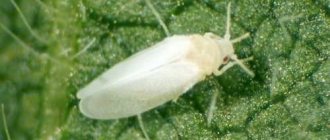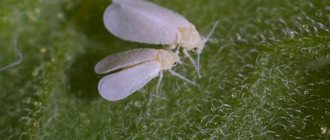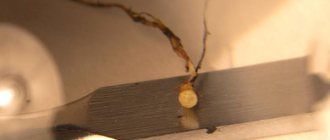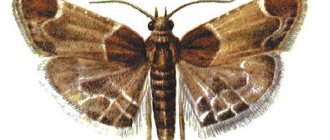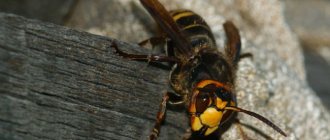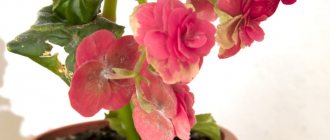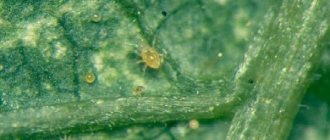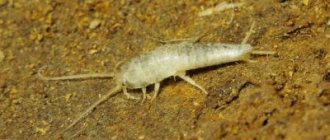How to deal with a pest
To rid strawberry plants of pests, folk remedies and preparations of biological origin help a lot. In advanced cases, chemical methods will come to the rescue.
Folk recipes
Traditional methods cannot completely destroy the pest, but they are quite capable of reducing its numbers several times and ruining the appetite. They are used during flowering, ovary formation and fruiting.
To combat whiteflies, gardeners spray strawberries with repellent compounds and place sticky baits.
The following recipes are suitable for spraying:
- 1–2 heads of garlic are peeled, crushed, filled with water for a day, then filtered, bringing the contents to 3 liters;
- A glass of ash is mixed with a liter of water and boiled for half an hour. The cooled broth is filtered, a little green or laundry soap is added, and poured into a bucket of water;
- 200–300 g of citrus peels are poured with water and left for one day. Then filter, generously moisten the leaves on all sides. The product effectively repels aphids and ants.
Baits are an excellent way to combat whiteflies. You can make them yourself or buy ready-made ones in the departments of country goods - these are yellow sticky strips.
The whitefly is extremely partial to the cheerful color, flies towards it and is guaranteed to stick. You can also make sticky traps yourself from a mixture of liquid Vaseline, castor oil, and honey. Have children cut out different shapes from yellow cardstock, then coat the crafts with the mixture. Such traps are placed in the garden bed and replaced periodically.
Biological control agents
Not only children, but also predatory insects can be involved in pest control. These include the macrolophus bug and encarsia. You can buy such biological material in large garden farms or laboratories. Bugs released into strawberry beds actively eat whitefly larvae. They do not cause any harm to strawberries. After the plantation is completely cleared of white midges, the predators move to another place.
An equally effective and harmless remedy is the drug “Verticillin F”, which contains fungal spores that have a detrimental effect on whiteflies. After processing the strawberries, the spores penetrate the body of the pest, affecting its organs, which leads to death.
The drugs Fitoverm and Vertimek have a similar effect. They are based on natural substances that kill whiteflies and other small garden pests. These drugs are characterized by low addiction and a wide spectrum of action.
Chemical treatment
After fruiting is over, chemical agents will help to completely destroy the insect. Insecticides are divided into 3 groups according to the active substance and method of action on pests:
Pyrethroids. They have a contact-intestinal effect. Whiteflies enter the body with food and poison it. The group of pyrethroids includes such popular drugs as Iskra, Cypermethrin, Decis, Caesar. They do not harm humans and act quickly on insects. The disadvantage is that pests quickly become accustomed, so they are not used more often than indicated in the instructions. Organophosphorus preparations. These include the well-known Actellik, Fufanon
These products are toxic to bees and fish, so use them with caution. Remains of the drug should not be poured into open water. Systemic insecticides with neurotoxic effects
Preparations Aktara, Confidor, Mospilan. These are effective means of combating many pests. Used for spraying and root watering.
Gardeners respond positively to the new drug Rovikurt. It is a synthetic pyrethroid with enteric contact action. Helps fight whiteflies, Colorado potato beetles, cutworms, leaf rollers, codling moths, and even skin parasites of animals.
Signs of plant infection
In order to determine that plants have been attacked by pests, it is necessary to periodically inspect the leaves. Detecting the appearance of whiteflies is quite simple:
- After touching any part of the plant, a huge cloud of midges rises.
- On the underside of the leaves you can find the appearance of a sticky substance called honeydew, with larvae in the form of translucent scales.
- On the leaves there are signs of fungus in the form of dark, putrefactive spots.
- The leaves first curl and then begin to die.
- The plant stops developing and begins to wither.
- Plants may begin to curl their leaves and develop chlorosis.
After detecting a pest on a site or in a greenhouse, complex treatment using folk and chemical means will be required. Indoor plants infected with whitefly must be isolated in a separate room, where work will be carried out to destroy the pest.
How can you tell if there is a whitefly in a strawberry patch?
A parasitic insect cannot be immediately detected, but when it is noticeable, it means that a large number of them have already bred. You can determine that a midge has settled in a garden bed by the following signs:
- Having settled on a bush, they climb into the very middle of it. Therefore, when inspecting a strawberry bed, you need to inspect the leaves from the inside or slightly stir the plant. If there are butterflies, they will scatter in different directions.
- Armed with a magnifying object, you need to carefully examine the back side of the sheet plate. There insects lay their eggs, which are very hard to see because they are transparent green or transparent yellow.
- Midges on strawberries leave a discharge in the form of a white coating.
- If insects have been living for a sufficient amount of time, this can be seen in the plants themselves. The bushes will become weak and withered, the leaves will lose their color, then completely turn yellow and dry out.
What is the danger to strawberries?
Due to the abundant feeding of plant juices in large quantities, not all of their volume is absorbed in the whitefly’s body. Therefore, the insect secretes a whitish liquid, similar to dew, which is located on the leaves. This substance is a favorable environment for sooty fungus to live.
Therefore, a gardener whose strawberries have been attacked by a whitefly will face additional problems.
After all, the fungus disrupts the flow of air to the leaf plates of the plant and interferes with the vital course of photosynthesis. The result will be the formation of a sticky crust on the plants, blackening and death of the green part
Whiteflies are also carriers of diseases.
Despite its small size, this parasite causes significant damage to strawberry plantings. But, knowing what whitefly looks like on strawberries and how to fight it, you can save the plants and the future harvest. The main thing is to take the necessary measures in time.
Signs of parasitism and the danger of whiteflies
The main symptoms of the appearance of a pest on strawberry bushes:
- She lays eggs on the reverse side of the leaf blades; they are easy to notice if you turn the leaf. You can simply run your hand along the foliage of the bushes and you will immediately see how a cloud of small midges rises above it - these are whiteflies.
- A whitish coating appears on the leaf blades - this is whitefly secretion.
- The foliage dries out, becomes dull, and the plant begins to wither.
The main danger of the pest is that it sucks out all the cell sap from the strawberry foliage. As a result, the plants become weaker, so they can be affected by various diseases. Weakened strawberry bushes bear fruit worse, their fruits lose their taste and become small.
Preparations for whiteflies
Many people consider the right way to control pests to be the use of chemicals that are sold in specialized stores. When used correctly and in accordance with the dosage, they are completely safe for plants and effective against pest infestation.
However, preparations for whiteflies can be harmful to people, so treatment must be carried out using personal protective equipment:
"Teppeki" for whiteflies is a systemic insecticide. Water-dispersible granules of this drug, entering the insect’s body, act in such a way that the pest stops feeding and, after some time, dies. The duration of the drug is 30 days. When treating whiteflies with this drug, you need to follow some rules. For example, the preparation of the solution should be done on the same day that the treatment will be carried out. The granules are dissolved in warm water at the rate of 1 g per 2-3 liters. Spraying should be carried out in dry weather in the morning or evening. If the procedure is carried out in a greenhouse, then after finishing the work it must be well ventilated.
“Aktara” for whiteflies is used quite often because it is a strong systemic insecticide. The drug can be used for watering or spraying. In the first case, 1 g of product will be required per 10 liters of water. When preparing a solution for spraying, the concentration of the drug is much less: 1 g of the drug needs to be dissolved in only 1.25 liters of water. This amount should be enough to process 30-35 plants. To achieve complete disappearance of butterflies, spraying should be carried out every 2 weeks (3-4 times in total).
"Fitoverm" is also often used against whiteflies. The instructions for using the drug say that this is a contact-intestinal insectoacaricide, in addition to combating whiteflies, it can be used when infecting plants with aphids and various types of mites. Humidity and air temperature determine how long after treatment the plantings will be protected from pests. Typically this period varies from 5 to 15 days. In greenhouse conditions, protection lasts longer - 2-3 weeks.
“Iskra Zolotaya” is a modern drug used to destroy whiteflies, aphids, midges, and the Colorado potato beetle. The drug is considered highly effective and has a long shelf life. After treating plantings with Iskra Zolotoy, even those insects that survived earlier, after being treated with another drug, die. The death of whiteflies after spraying with this product occurs within 1-2 days.
Timing and schemes for processing strawberry bushes
When spraying strawberry plants to get rid of whiteflies, you must choose the period when flying insects appear. Even insecticides do not have a noticeable toxic effect on the larvae.
Several treatments are practiced during the season, taking into account the breeding cycle of harmful insects. If chemicals are used, then when preparing the solution, its concentration is gradually reduced. This measure avoids damage to plants. Spray strawberry plantings in the evening or early morning. Calm, dry weather is optimal.
Methods for controlling whiteflies in the garden
The ideal conditions for this insect are a hot, long summer and fairly high air humidity.
However, if the temperature drops below 10 degrees, then its larvae stop growing and adults stop reproducing. But laid eggs tolerate these changes well and, for example, can be transferred with soil to a greenhouse, where larvae will certainly hatch from them.
It is not easy to destroy this malicious pest, and it is necessary to carry out a whole range of measures to combat it. But basically they can be divided into two categories
- folk remedies
- chemicals
First of all, control measures can be based on the fact that the insect can be destroyed when it has just “settled” on the plant. At this moment, it is just possible to intervene in its development cycle and destroy it, while the female has not yet had time to lay eggs.
What are these methods?
1. One of the effective methods during this period is to wipe or spray the leaves of plants with soapy water. However, it is justified if you have a small number of them growing.
If there are a lot of green pets, then this process will be too labor-intensive.
But I will still describe this option; it is applicable for many plants. What needs to be done?
Just once a week, wipe the leaves with a soft sponge dipped in soapy water. In this case, you should try not only to wet the surface with soapy water, but also to remove the larvae. You can also spray the seedlings using a sprayer. This method is especially applicable in greenhouses where plants are planted quite densely.
The solution can be prepared as follows. Grate the laundry soap into shavings and dissolve it in water in a ratio of 1:6. Before applying it to the plant, beat the solution until foamy.
You will need to spray not only the plants themselves, but also the soil around them in order to destroy the larvae deposited in it.
2. Among folk methods, a method is also used in which an infusion of garlic is made. To do this, chop a couple of cloves of garlic (more is possible) into smaller pieces and add a liter of water. Place the jar in a dark place to infuse. After which the seedlings should be treated once a week for two to three weeks.
3. Butterflies also do not like dandelion infusion. Both roots and leaves are used for its preparation. You should take 40 grams of both and grind them by slicing. Then fill it all with a liter of water. It will take a little longer to infuse than garlic, namely 4 days.
After this, the solution is ready for use. You will need to spray the plants with it twice, with a break of one week.
4. As for chemical control methods, there are quite a lot of drugs. And you can always buy them in the store.
One of these drugs is Iskra. It is highly effective. And therefore it is available both in the form of powder and in the form of sticks, and it can also be purchased in ampoules, which are diluted in a certain amount of water. according to instructions.
This product is especially useful for watering. It penetrates the plant through the soil and exerts its effect on insects within 25 days. Eating the leaves of such plants, the butterfly dies.
However, be aware that when you use such preparations, there are certain periods during which the fruits of the plant, its leaves and stems cannot be eaten. Therefore, read the instructions carefully!
Other similar remedies include Fitoverm, Akarin, Zeta, Alatar, etc.
And then we will look at how to fight the pest on various plants in our garden.
White midges on strawberries: how to get rid of them
Small insects can cause great damage to plants.
If pests are detected in time, you can quickly and effortlessly preserve the crop. But white midges on strawberries that are not removed in time can cause irreparable damage. These small insects are called whiteflies. They lay larvae on the bottom of the leaves, which begin to eat the plant itself. It is the larvae that harm the plant, not the adults.
The midges themselves are practically invisible, because... they reach 1.5 mm in size. This makes them very difficult to see. But if you find a huge accumulation of midges as small as dust, then you need to take urgent measures to save green spaces.
In addition, small holes in the leaves can be one of the signs of pests.
Whitefly, portrait of a pest
Whiteflies, or aleurodids (lat. Aleyrodidae) are a family of small homoptera insects (Homoptera) from the suborder Sternorrhyncha (Hemiptera).
There are about 1550 species in the family. The scientific name comes from the Greek word aleuron (flour) due to the powdery coating on the wings, and the Russian name comes from the presence of 2 pairs of white wings (from Wikipedia).
These insects can settle on absolutely all plants in a garden plot, and also love to settle in greenhouses. And this is no coincidence, because their homeland is South America, where it is always warm. And it is the greenhouse climate that is most comfortable for them.
If you take a closer look at them, they are very small butterflies, no more than 2.5 mm in size. Therefore, detecting their population is not easy. Moreover, they initially settle on the lower part of plant leaves.
And you can see them only by disturbing a bush or branch. In this case, they take off, hover around their shelter for a few seconds, and land back. Having chosen a “home” for themselves, they do not fly far from it, but swarm nearby.
The insect is very voracious and can destroy almost all plantings. They literally suck all the juices out of the leaves. At the same time, the green cover darkens, curls, the plant becomes oppressed and gradually dies.
The female butterfly is extremely fertile. During the season it gives from 10 to 15 generations. And each individual is capable of laying from 130 to 290 eggs in one clutch. And just imagine, after 40 days, all the young individuals are already capable of laying eggs.
And, although in cold weather its ability to reproduce is reduced, it itself does not die, but waits out bad weather conditions in the upper layer of soil, or under fallen leaves.
Outwardly, these pests resemble small moths, although they have nothing to do with them. The 4 wings of these insects are covered with a dusty powdery coating. This can be especially clearly seen through a magnifying glass.
Whitefly larvae are pale yellow in color, very small in size - up to 0.8 mm. They live exclusively on the underside of the leaf.
The harmful effects of this insect are twofold.
On the one hand, pests directly eat plants, on the other hand, by secreting a sweetish liquid onto the surface of the leaf, they thereby lead to the appearance of fungus. As a result, the leaves may turn black and curl. At the same time, productivity decreases sharply.
Among all plants, tomatoes, cucumbers, lettuce, celery and some flowering plants are most susceptible to butterfly attack.
Therefore, at the first sign of its appearance, you should immediately begin to destroy this pest. Although it must be said that this is not an easy task. And you need to have patience and time to fight it.
Pest Information
Whiteflies are the name of a large family of insects, which includes over 1,500 species. Several dozen of them are widespread in the territory of the former USSR and pose a threat to garden and vegetable plantings. This family got its name because of the characteristic waxy coating on the wings of its representatives.
Externally, whiteflies look like tiny moths
These are small insects: the length of adult individuals ranges from 1.5 to 5 mm. They feed on plant juices, and at the same time draw them out in large volumes, exceeding the required amount for nutrition.
If measures are not taken in time, the parasitic activity of whiteflies will ultimately lead to the death of the plantings.
The main enemy of strawberries is the strawberry whitefly (Aleurodes fragariae Walk). These insects lay yellow eggs for the winter in the stems of berry crops and herbaceous plants located nearby.
Folk remedies for whitefly
It is not always and not everywhere possible to use chemical methods to combat whiteflies. In such cases, proven folk recipes come to the rescue, based on the properties of the most common products: onions, garlic, lemon.
- If there are not too many butterflies and the plantings are not very extensive, you can simply wash the leaves on both sides with warm water and loosen the soil near the plants, where the larvae are probably already deposited.
- Garlic tincture, which you can prepare yourself, will help repel parasites. To do this, grind 100 g of peeled garlic, add 1 liter of water and leave for 7 days. The resulting mixture is filtered and poured into a tightly closed container. To process strawberries, dilute 10 ml of garlic infusion in 1 liter of water and spray the strawberry bed. Treatment should be carried out once a week.
- Planting garden strawberries can be treated with a decoction of lemon peels. To prepare a repellent, peels collected after peeling 5 lemons are boiled in 1 liter of water for an hour. The solution is cooled and the strawberry leaves are sprayed with it.
- An effective and fast-acting remedy to get rid of whiteflies is laundry soap. Once a week, the stems and leaves of plants are treated with a soap solution.
Winged pests are most likely to appear in hot and humid weather. As soon as the air temperature drops to +10°C, the entire colony of insects dies.
To prevent the appearance of whiteflies on strawberries, you should not plant the plants very close to each other, as the plantings should be well ventilated. In wet weather, it is better to refrain from watering and spraying, so as not to create conditions favorable for the proliferation of parasites.
Having discovered a whitefly on a strawberry, you must immediately take all possible measures. Otherwise, the pest will quickly spread throughout the entire area and the danger will threaten not only strawberry plantings, but also other cultivated plants.
Prevention
The practice of growing strawberries shows that the more attention you pay to this berry crop, the fewer misfortunes it suffers.
And yet, the best way to preserve the harvest is timely prevention. What does that require?
- Maintain distance when planting strawberry bushes.
- Ensure good ventilation of the greenhouse.
- Do not water or spray plantings in conditions of high humidity.
- Use biostimulants and biological pest control methods.
- Remove dried plants, weeds, and dig up the soil before wintering.
- Disinfect greenhouse premises.
How to fight?
Whiteflies can be controlled with chemicals or traditional methods. Poisons are used as a last resort, when the harm from them is less than the damage from whiteflies.
Chemicals
Effective drugs for use against whiteflies are:
- Aktara. A universal action insecticide, widely distributed, affordable price. A sachet of the drug is diluted in 5 liters. water, spray the leaf apparatus and the ground around the bush.
- Actellik. A very strong drug, ampoules are used no more than four times a season. The effect is visible 3 days after use. Considering the frequent use of Actellik against strawberry mites and weevils, one drug will help to cope with a complex of pests at once.
- Rovikurt. The oily liquid, which is used on large plantations, is practically not found in garden stores.
- Biological product Verticillin (Verticillium lecanii) based on fungal spores. The fungus penetrates the insect and destroys it. Verticillin is recommended specifically against whiteflies, but phytoverm, which is popular among many gardeners, will help cope with the pest.
- Any flea treatment containing the substance fipronil will help get rid of the insect. You can buy them at veterinary pharmacies. The shampoo is diluted in water and sprayed on the foliage. The spray is sprayed on the ground around the bushes.
Adults are killed with pesticides. They have no effect on eggs. Therefore, it is necessary to carry out several spraying procedures - approximately 2-3 procedures with an interval of 5-7 days. Over time, the whitefly becomes immune to one or another drug, so it is better to change them. Spray strawberries in the morning or evening hours. Bright sunlight may cause burns on treated foliage.
Insecticides should not be used frequently or in large quantities. They accumulate in the ground. It is very difficult to make it environmentally friendly again.
Folk remedies
Chemicals are popular, but the environmental safety of soil and crops is jeopardized. It is especially undesirable to use pesticides in greenhouses, since they will accumulate there at a tremendous speed, and in addition, a gardener indoors can become poisoned. For example, Actellik shows good results in open ground, but using it at home for strawberries in a pot is simply unacceptable.
The following gardener-tested recipes will help you fight garden pests without toxic substances:
- Butterflies and larvae are removed by directing a stream of water onto the leaves.
- Sticky traps are set. A piece of plywood is smeared with castor oil or honey and a few drops of rosin are added. The bait is placed next to the strawberry bushes. You can also use a commercial fly trap.
- Garlic infusion repels pests. Several heads are crushed and 5 liters are poured. water. They insist for three days.
- Infusion of yarrow herb. (80 g of crushed raw materials are scalded with boiling water, then added to 1 liter with water and infused for 24 hours)
- A solution of crushed laundry soap (or any liquid) is safe for strawberries and humans, but harmful to insect pests. At the same time, this is an excellent remedy for the development of fungal infections that whiteflies could bring to the beds.
- Peels from lemons, oranges and tangerines will also help control whiteflies. Peels of 5-10 citrus fruits are boiled in 5 liters. water for 30 minutes. It is necessary to spray with this solution every 3 days for a month.
It is advisable to alternate different means, so you can be sure that the pest will not resist. Spraying is recommended in calm weather when no precipitation is expected in the near future.
Biological method
There is another method - biological. It is usually used by large farms. Predators - insects (encarsia or macrolophus bugs) are allowed into the strawberry beds. They are not dangerous for strawberries; they feed on eggs from whiteflies. After they clean the bush, they leave it. The macrolophus bug will also free the plantings from spider mites.
Simple methods of struggle
You can fight whiteflies using both chemicals and folk methods. The majority of special products are characterized by good effectiveness due to the fact that toxic elements enter the plant tissue and penetrate the juice. After feasting on this substance, both larvae and adults die within a couple of hours. But at the same time, we must not forget that laid eggs can survive. Therefore, the bush needs to be treated several times, and an interval of one week between treatments is required.
Special mention should be made of special fumigators and insect traps. To completely get rid of pests, it is necessary to use them for quite a long time, and all because they can only destroy adult individuals.
Using traps
Special glue traps that hang above the plants themselves can help get rid of insects. There are many companies that produce them, for example:
- "Bona Forte";
- "ARGUS";
- "Pheromone".
The trap itself is a small piece of cardboard with an adhesive composition on the surface that is colorless and odorless, and is also completely non-toxic to humans.
The bright yellow color attracts this insect, and the whiteflies stick to the cardboard upon any contact. But not only these butterflies fall into the trap: it can help rid your garden plot of moths, aphids, ticks, mosquitoes, and miners.
You can easily make traps yourself. Why you will need cardboard, which must be cut into small rectangles and painted yellow. Then the surface must be treated with castor oil or a mixture of honey and rosin.
The holder is made of plastic, wood or metal. Manufactured traps must be installed above the affected bush itself. Store-bought traps most often come with a thin wire, with which a piece of cardboard is secured above the flower. If a whitefly was found in a greenhouse, then these traps must be hung 1 piece at a time. for 10 sq. m. For home use, one trap is installed on all windows.
Installation of a fumigator
A fumigator designed to combat mosquitoes and flies can help significantly reduce the whitefly population. You should close the windows and doors tightly and connect the fumigator, installing it near the infected bush. Moreover, all residents need to leave the premises, as there is a risk of poisoning.
Who are these white midges?
When white midges or strawberry whiteflies appear on strawberries, you need to sound the alarm.
This is the most dangerous and worst enemy of the plant, although in appearance it is very attractive. Most often it hides on the inside of the petal. It can be confused with a moth or a small butterfly. If you touch its wings, you can see that they are covered with a white waxy coating. This insect has two long rather than wide wings. It is small in size, no more than 3 mm. The whitefly is afraid of direct sunlight, so it hides in the shade of leaves. This is a very prolific insect, and in one spring-summer season 4 generations are replaced. One female whitefly can lay up to 20 eggs, from which larvae will emerge; they are quite active. These larvae attach themselves to the leaf and begin to feed on its juices. During the period of degeneration of the larvae into an adult, their whiskers and legs disappear.
